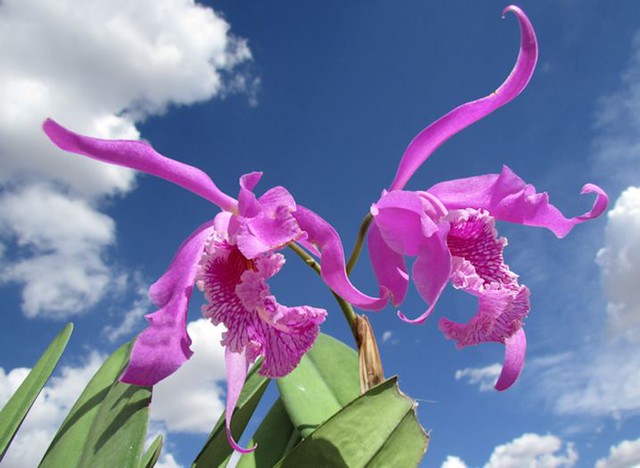These orchids are endemic to Ecuador and Peru. This is the medium sized upland short p-bulbed unifoliate type the average leaf is about a foot long; the flowers are about 5 inches in diameter sweetly fragrant, long-lived flowers of heavy substantial texture with vivid dark purple color that the sun must have washed in my picture.ůmy plants are in active growth and have not been divided since I got it as a gift 3 years ago from Cynthia of Kissimmee, FL and it is going to need to be either repotted or divided in the next 3 to 4 months.
Cattleya maxima is one of the few species of the large-flowered Cattleyas that are easy to identify from their color and a characteristic yellow stripe down the center of the lip and throat in all color forms including the albas. The bright yellow stripe is quite striking against the dark purple flowers of the short-pseudo bulb type.
Forms of Cattleya maxima: one with short and one with tall pseudo bulbs, are easy to grow, their cultural requirements are somewhat different. They both begin growth period in the spring in the US and both flower in late spring to early December, but their night temperature requirements are not the same.
As a mountain plant, my short-pseudo bulb C. maxima require the normal Cattleya night temperature of 58 F, and can take temperatures down to the low 50s without problems whereas the tall-pseudo bulb C. maxima, however, grows near sea level, where night temperatures are in the high 60s F to low 70s F. To grow the tall-pseudo bulb C. maxima well, the night temperature should not fall below 65 F, so you should put them in the warmest part of your environment. Day temperatures for both types of C. maxima should be about 85 F. The upland C. maxima likes more sun than the lowland, but both grow best if their leaves are light green=meaning it is given brighter light. Both forms also benefit from lots of moving air. The upland C. maxima often have some purple pigment on the leaves, while the lowland is normally just green. To enjoy the full size of the tall pseudo bulbs of the lowland C. maxima, the plant must develop a good root system, and it will help to keep the plant slightly under potted.
I prefer to grow my C. maxima in clay pot because the pseudo bulbs seem to grow better when grown in pots with the additional moisture they receive. I repot as soon as the plant makes new roots from the lead pseudo bulb and I fertilize only when it is actively growing in the spring and summer= I hold fertilizer in winter.










































 Threaded Mode
Threaded Mode
